MXA’S 2014 YAMAHA YZ450F MOTOCROSS TEST: WHEN YAMAHA FIRST WENT BACKWARDS THEY GOT IT BACKWARDS, BUT NOW THEY ARE STRAIGHTENING IT OUT
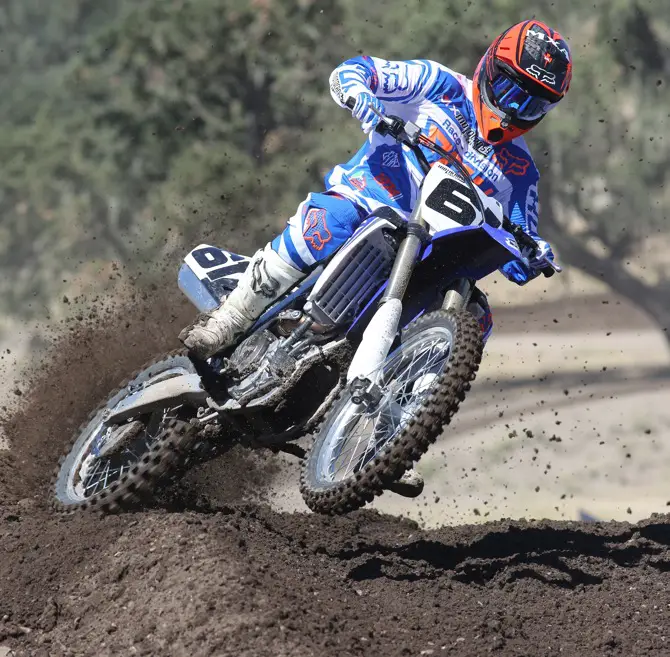
FIRST AND FOREMOST, IS THE 2014 YZ450F BETTER THAN THE 2013 YZ450F?
A: Let’s be honest, James Stewart and his minions put the Yamaha YZ450F in a precarious position when he quit midseason last year (although it should be noted that Bubba won 8 AMA races on the backwards engine YZ450F before declaring it unfit). Bad word of mouth stalled YZ450F sales, but Yamaha insisted on waiting out their four-year production cycle before trying to fix the flaws?or perceived flaws. Yamaha can breathe again, because the 2014 Yamaha YZ450F is better than the 2010?2013 versions.
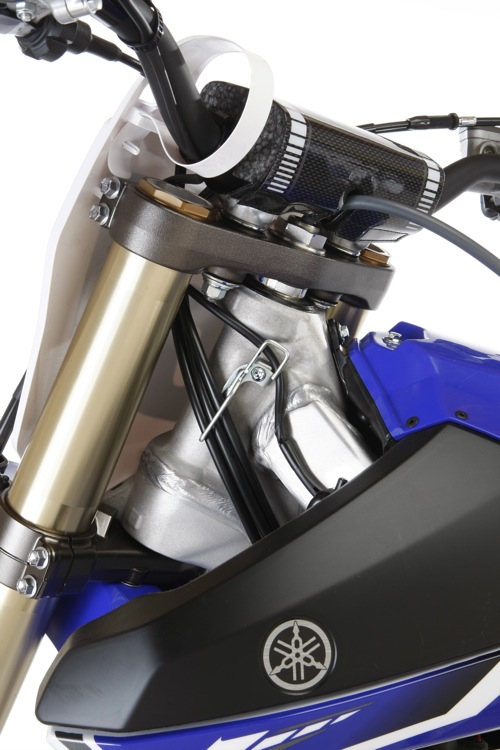
Q: WHAT ARE THE MAJOR CHANGES THAT YAMAHA MADE TO THE 2014 YZ450F?
A: This bike was not released into a vacuum; there has been more prerelease publicity about the 2014 Yamaha YZ450F than any other bike this year. Why? Because the YZ450F, YZ250F and Honda CRF250 are the only bikes that got remakes for 2014. The KTMs, Kawasakis, Suzukis and Honda CRF450 are mildly reworked clones of the 2013 models. For those who have been hiding in a bunker somewhere, here is a quick primer on what’s new on the YZ450F.
(1) What didn’t they change? The rear wheel, front fender and brakes.
(2) What did they change? Everything else.

Q: IS THE 2014 YZ450F FASTER THAN THE 2013 YZ450F?
A: Yes. Even though the 2014 engine shares last year’s slant-back architecture, it is a totally new design. In a head-to-head comparison against the 2013 YZ450F, the 2014 model blows it out of the water in the power department. Off the bottom, the 2014 engine is much stronger (although still plagued by the same irritating abruptness off idle that wreaked havoc on the 2010?2013 YZ450F’s handling). The added torque really helps keep the 2014 YZ450F moving. Last year, the YZ450F hit hard off the bottom, sagged through the middle (6500 rpm to 8000 rpm) and then perked up from 8000 to 10,000 rpm. There wasn’t a single MXA test rider who liked the previous YZ450F’s split-personality powerband. It hit too hard down low, laid down on the job in the middle and picked up when it was too late to use it. It was three different powerbands in one engine. Not good. We wanted a unified powerband.

2014 Yamaha YZ450F: For 2014 Yamaha landed more on the good side of the scale than on the bad. The powerband, suspension and overall handling are improved, while the gearing, mapping and brakes need more thought.
Q: DID WE GET A UNIFIED YZ450F POWERBAND?
A: Yes. Horsepower is up at every rpm from idle to sign-off. Torque is boosted from bottom to top, and the horsepower numbers have jumped 2.25 horsepower at peak. To top it all off, peak isn’t even the most impressive part of the 2014 YZ450F power curve. At 7500 rpm, where last year’s engine tended to go soft, horsepower is up three full ponies. The cherry on top of the 2014 YZ450F cake is that it doesn’t fall off after peak like the 2013 engine did. Last year, when the YZ450F engine peaked at 9100 rpm, it lost 2-1/2 horsepower in the next 1000 rpm. For 2014, peak horsepower is at 9900 rpm, and when it signs off at 11,000 rpm, it is still making more power than the 2013 model made at peak. That is usable power from bottom to top.
Q: IS THERE A CATCH TO ALL OF THIS HORSEPOWER?
A: Yes and no. The abundant power is there, but the 2014 Yamaha YZ450F is lean. Even scarier, it is lean on 95-degree days, which means in the cool, oxygen-rich days of fall and winter it will be uber lean. With the stock mapping, the YZ450F stuttered down low and felt like it coughed when landing from jumps.
The MXA test riders only ran the stock mapping for an hour before breaking out the GYTR Power Tuner to pump up the fuel percentages and advance the ignition timing (to help burn the extra fuel). The caveat is that our dyno runs and testing have been done with different mapping from stock.
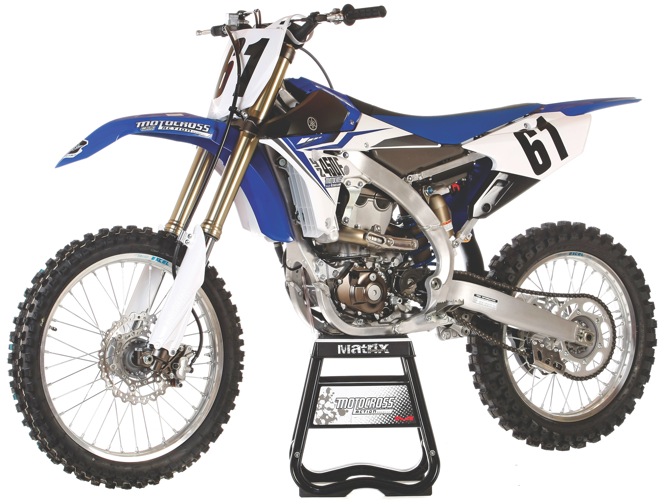
Q: HOW DOES THE 2014 YZ450F RUN ON THE DYNO?
A: Maximum horsepower on our 2014 YZ450F was 58.17 ponies. That makes it the most powerful 450cc production engine we have ever tested, besting the previous horsepower leader, the 2013 KTM 450SXF, by more than a horsepower.
You can take this to the bank: the 2014 Yamaha YZ450F dyno curve is a parabolic thing of beauty. It climbs without any of the dips of last year and keeps on going until the cows come home (once it is remapped).

Q: WHAT IS THE RELATIONSHIP BETWEEN THE ENGINE AND THE CHASSIS?
A: If you put on your thinking cap and stand back, you can see that the overall design of the Yamaha engine isn’t solely about producing power, although it does that in grand fashion. In truth, the slant-back YZ450F engine was conceived to make the YZ450F handle better. Okay, we admit that from 2010 through 2013 the handling benefits of the unique engine design were muted by issues with a front-end push that was aggravated by the barky low-end hit. The front would wiggle going into a corner, and the bark would lift the front on the exit?not a confidence-building combination.
Not surprisingly, the best fix for the 2010?2013 handling was to remap the engine to eliminate the bark, add a flywheel weight to tame the lift and put a longer link on the rear end. These fixes aptly highlight the crossover effect of power delivery on chassis dynamics. The chassis and the engine are not independent entities but work in unison, or else they work against each other.

Backed up: The gas tank has been moved rearward so far that the fuel pick up is behind the shock.
Q: HOW DOES THE 2014 YZ450F HANDLE?
A: The handling is better in 2014 than it was in 2013, but in a way that is kind of disappointing. When a manufacturer goes all in on a new design, it is human nature to assume that it will be better on all fronts. So, we enthusiastically expected every aspect of the 2014 YZ450F to blow our socks off. The 2014 YZ450F’s handling didn’t do that.
Most MXA test riders complained that the bike had a stinkbug feel. The high-in-the-rear and low-in-the-front stance steepened the head angle enough that the front wheel hunted and pecked on the entrance to turns. We opted to run 105mm of sag to bring the rear of the chassis down, but this isn’t the optimum fix, because you are compromising the rear suspension to band-aid the chassis.
Eventually, we settled on a 1.5mm-longer shock linkage and a better front tire for our terrain. The YZ450F rolls off the showroom floor with the new Dunlop MX51FA (the upgraded brother of the less-than-stellar MX51). Neither the MX51 nor MX51FA would be our first tire choice for intermediate terrain, and especially not for a bike with a loose-feeling front end.
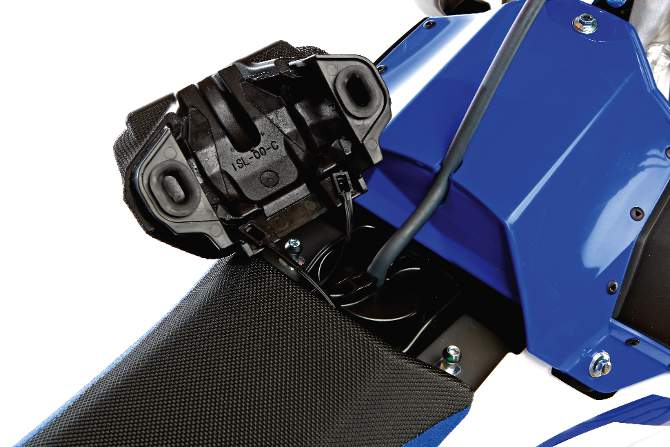
Hide and seek: The gas cap is under a flip-top flap.
Q: WHAT DID WE HAVE ISSUES WITH?
A: The MXA wrecking crew had some problems during testing. These were our main concerns:
The gearbox. Yamaha lowered third gear to close up the gap between second and third, which has been a bugaboo for a few years. Unfortunately, they also changed the primary gear ratio to move all the other gears up. The result? While the gap between second and third is closed up, the gap between third and fourth is widened. To help mitigate the problem the new primary gear created, Yamaha installed a 49-tooth sprocket in place of last year’s 48, which allowed the 2014 gearbox to mimic last year’s 48-tooth gearing, but did nothing for the new gaps. At every race, the MXA test riders carried a quiver of sprockets?from 48- to 51-teeth?to allow each test rider to choose what he wanted to race with. In the end, the consensus was the 50-tooth sprocket.
The mapping. The GYTR Power Tuner has room for 9 different maps?and we used every one of them. In the end, we settled on a version of the “Travis Preston map.” Preston did the development riding on the YZ450F during the pre-pro stage and came up with the map that we elected to run, even though it was rich on fuel and advanced on ignition. The more time we spent with the map, the more we fine tuned it. In the end the MXA map (shown below) is slightly different from the Travis Preston map. In an odd note, we ran our richer and advanced map with the stock exhaust pipe, but when we switched to aftermarket pipes it didn’t work as well?so, we would return to the stock zero/zero/zero map or a special one we developed for exhaust system (with the stock ignition timing and slightly richer fuel mapping).
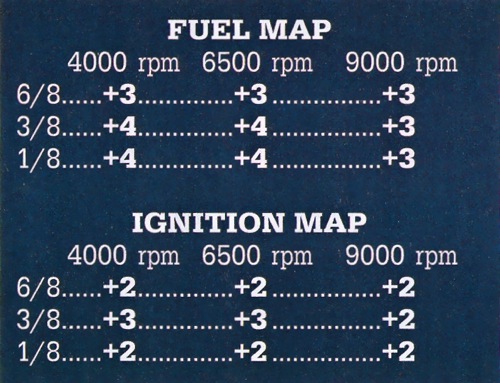
This is MXA’s map for the YZ450F with the stock exhaust system. To make this change, you need the GYTR mapping tool or a friend with one. It only takes seconds to change a Yamaha map.
The brakes. What brakes? Has anyone at a Japanese motorcycle manufacturer ever ridden a KTM? If not, they should, because that is the gold standard of braking performance. The Honda, Yamaha, Kawasaki and Suzuki are closer to the lead standard.

Q: WHAT WERE THE HIGHLIGHTS OF THE NEW YZ450F DESIGN?
A: There is no doubt Yamaha listened to consumers when it came time to redesign the YZ450F. Here are the bright spots.
Airbox. We hated the old airbox design with a passion. It required taking the bike apart to get to the filter, and that included removing the seat and the gas tank. Thankfully, Yamaha rethought their foolishness and made an airbox that can be accessed by removing three bolts (and unplugging two rubber plugs).
Airbox noise. The noise that emanated from the 2010?2013 airbox was a cacophonous clatter of mind-numbing volume. The new airbox is much quieter.
Hidden gas cap. We may not like how amateur the gas-cap vent hose looks, but our angst is lessened by how clean the hidden gas cap is. Yamaha isn’t pioneering new ground here (Husqvarna has had gas caps sprouting from all sorts of places in the past), but the YZ450F design is clean.
Gas tank. It is moved rearward for more centralization of mass and holds more fuel than it did last year.
Wet sump. Last year the engine cases had an oil tank built in. This year, the engine runs on the oil in the sump. This not only reduced the amount of oil needed, but also the number of plugs that you have to remove to change the oil.
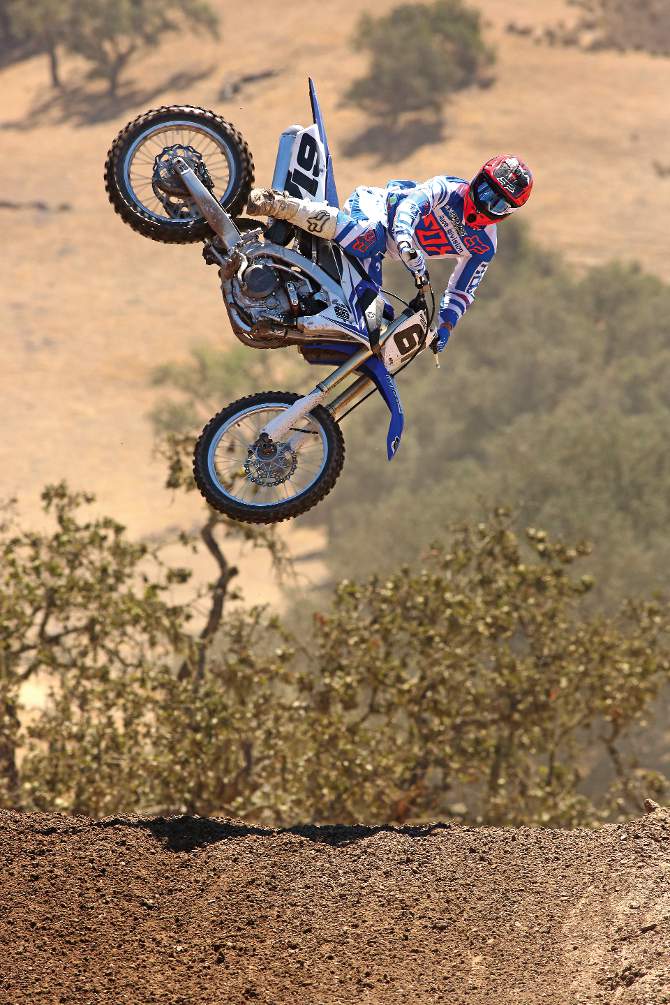
Older brother:?The 2014 Yamaha YZ450F is better than the 2010-2013 model, but its character remains the same.
Q: WHAT DID WE HATE?
A: The hate list:
(1) Yamathumb. We thought that this plight had been eliminated, but every MXA test rider wore a hole in the first knuckle of his throttle-hand thumb. A grip donut stopped the bleeding.
(2) Exhaust pipe. Given the overall design of the bike, the snake pipe is a good solution until you have to remove it. It is like taking three normal pipes off?and reaching the flange nuts that hold the pipe to the rear of the engine is a Houdini act that requires a long T-handle and a swivel socket.
(3) Gears. Experiment as much as possible to find what works for your local track.
(4) Mapping. The MXA wrecking crew made over 50 maps to test in the 2014 YZ450F. We tested with every possible speed of rider and finally settled on the perfect map. Then, we added an aftermarket exhaust pipe and the bike ran worse. We had to return to the stock map. But, unsatisfied, we made more maps and came up with a slightly richer version than stock that worked best with FMF, Pro Circuit, Yoshimura and DR.D pipes. MXA has the time to work our way through all of these settings, but if you don’t, use the map provided above with the stock pipe.
Q: WHAT DID WE LIKE?
A: The like list:
(1) Spring preload. Thanks to the slant-back engine design and snake pipe, there is abundant access to the new piggyback rear shock.
(2) EFI Power Tuner. Without Yamaha’s self-contained GYTR Power Tuner, we would have been hurtin’ for certin’. The retail price is $279.95. This is the easiest-to-use mapping tool available. The other manufacturers should adopt its Playstation simplicity.
(3) Reliability. Nothing is as reliable as a Yamaha YZ450F.
(4) Clutch. The YZ450F has the best clutch of any Japanese-made motocross bike. The 10-percent-stiffer clutch springs make it even better.
(5) Four-mount triple clamps. The cockpit is very compact. We moved the bars to the forward position to draw shorter riders forward on the saddle and give tall riders more room to operate, but every test rider returned to the bars in the back holes (with the eccentric bar mounts rotated forward).

Yamaha’s Kayaba SSS fork and shock remain the best production suspension for the seventh straight year.
Q: WHAT DO WE REALLY THINK?
A: As much as motocrossers like to pretend that they embrace creative new ideas, they don’t really trust innovation. There is comfort in the same old thing. So, when Yamaha blew out the cobwebs in 2010 with their slant-back engine, the buying public turned a cold shoulder to the inventive Yamaha YZ450F. It was too odd! Consumers were suspicious of the slanted cylinder, couldn’t find the throttle body, thought the airbox was too complicated, complained about the width and didn’t like the powerband.
Yamaha wasn’t without fault. Yamaha’s engineers engendered scorn with a bike that was poorly thought out and obviously rushed into production.
That is the bad news. The good news is that Yamaha’s engineers had four years to repent for their sins, and the 2014 Yamaha YZ450F is a bike built by men desperate to make amends for their previous transgressions. They had something to prove and their own reputations to save. The 2014 Yamaha YZ450F, while not perfect, is a much-improved bike this time around.
This is a better Yamaha YZ450F. Making it the best 450cc motocross bike is up to you and your setup skills.
MXA’S 2014 YAMAHA YZ450F SETUP SPECS
This is how we set up our 2014 Yamaha YZ450F for racing. We offer it as a guide to help you find your own sweet spot.
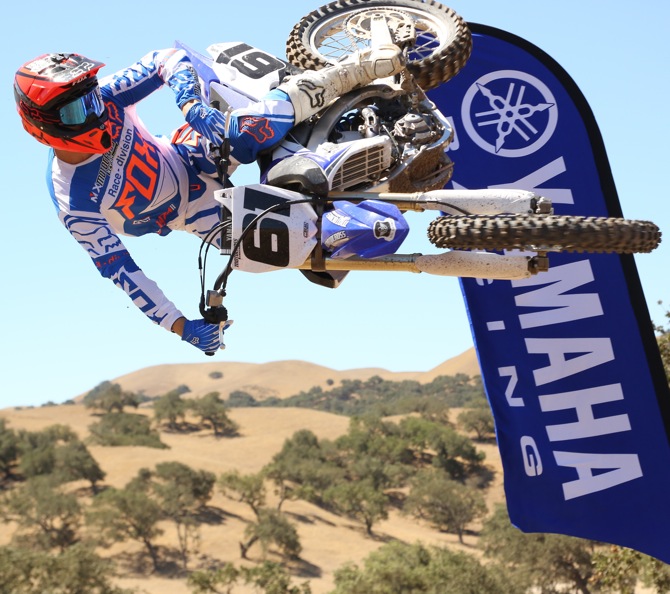
Setup: Balance and setup are the key elements to getting the most out of the 2014 YZ450F.
KAYABA SSS FORK SPECS
Yamaha is smart enough not to try to reinvent the wheel when it comes to suspension. While the other manufacturers scramble to find a semi-sweet spot, Yamaha has been sitting on the mother lode since 2007. Why mess with success? For 2014, Yamaha increased the rigidity of the upper stanchion tubes by 3 percent, polished the fork tubes to a higher sheen for better seal life, increased low-speed damping, enlarged the front-axle from 20mm to 22mm, upped the spring rate (from 0.48 Nm to 0.49 Nm), and lowered the oil height.
For hardcore racing, these are MXA’s recommended 2014 Yamaha YZ450F fork settings (stock settings are in parentheses).
Spring rate: 0.49 Nm
Oil quantity: 335cc
Compression: 11 clicks out (9 clicks out)
Rebound: 8 clicks out
Fork-leg height: 4mm up
Notes: Our Vet and Novice test riders thought the forks were on the firm side and turned the compression clickers out. The Pro test riders thought the forks were too soft and added 10cc of oil (but ran the same compression settings as the Novices). The oil height is lower in 2014, but because of the stiffer spring, which adds compression resistance and displaces more oil, the 20cc-lower oil height is not as dramatic as it seems. It is important that you get the chassis level by adjusting sag and fork height so that neither end is overloaded.

Staircase: The overall engine design mimics the 2010-2013 mill, but the 2014 engine is totally new.
KAYABA SHOCK SETTINGS
Because of the extra room found when moving the exhaust pipe forward, Yamaha was able to relocate the shock’s piggyback reservoir?from sideways in 2013 to vertical in 2014. This change doesn’t have any major effects on performance, but it is easier to work with.
For hardcore racing, these are MXA’s recommended 2014 YZ450F shock settings (stock settings are in parentheses).
Spring rate: 5.8 Nm
Race sag: 105mm (100mm)
Hi-compression: 2 turns out (1-1/5 turns out)
Lo-compression: 12 clicks out
Rebound: 9 clicks out (14 clicks out)
Notes: Yamaha stiffened the shock spring and changed the damping to accommodate the spring change. The shock is configured to work better for heavier and faster riders. Most MXA test riders preferred a lot more rebound damping. As for the race sag, we ran it low until we installed the longer, 143.5mm Pro Circuit shock linkage (although not solely for suspension purposes), but also to give us more adjustment room with the head angle and frame geometry. The longer link will drop the rear of the bike almost 8mm, so you will need to slide the forks up to keep the bike level.





Comments are closed.